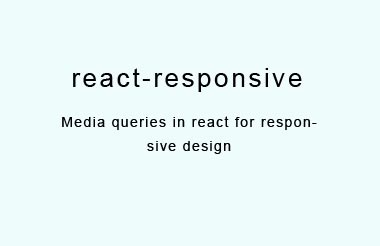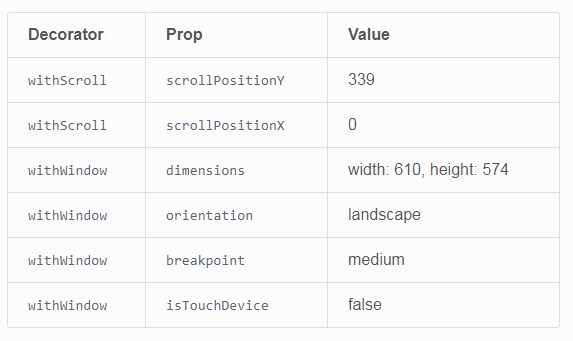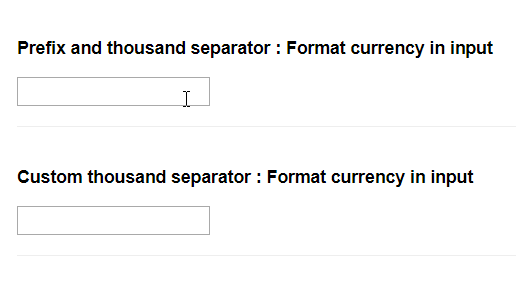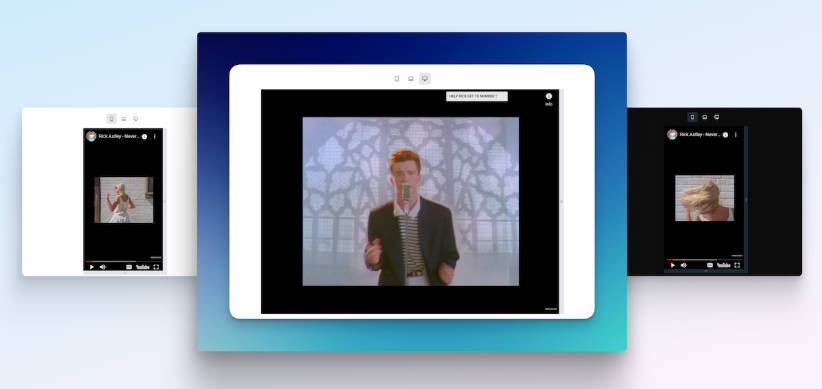react-responsive
Media queries in react for responsive design
The best supported, easiest to use react media query module.
This module is pretty straightforward: You specify a set of requirements, and the children will be rendered if they are met. Also handles changes so if you resize or flip or whatever it all just works.
Install
$ npm install react-responsive --save
Usage
A MediaQuery element functions like any other React component, which means you can nest them and do all the normal jazz.
Using CSS Media Queries
import MediaQuery from 'react-responsive';
const Example = () => (
<div>
<div>Device Test!</div>
<MediaQuery query="(min-device-width: 1224px)">
<div>You are a desktop or laptop</div>
<MediaQuery query="(min-device-width: 1824px)">
<div>You also have a huge screen</div>
</MediaQuery>
<MediaQuery query="(max-width: 1224px)">
<div>You are sized like a tablet or mobile phone though</div>
</MediaQuery>
</MediaQuery>
<MediaQuery query="(max-device-width: 1224px)">
<div>You are a tablet or mobile phone</div>
</MediaQuery>
<MediaQuery query="(orientation: portrait)">
<div>You are portrait</div>
</MediaQuery>
<MediaQuery query="(orientation: landscape)">
<div>You are landscape</div>
</MediaQuery>
<MediaQuery query="(min-resolution: 2dppx)">
<div>You are retina</div>
</MediaQuery>
</div>
);
Using Properties
To make things more idiomatic to react, you can use camelcased shorthands to construct media queries.
For a list of all possible shorthands and value types see https://github.com/wearefractal/react-responsive/blob/master/src/mediaQuery.js#L9
Any numbers given as a shorthand will be expanded to px (1234 will become '1234px')
import MediaQuery from 'react-responsive';
const Example = () => (
<div>
<div>Device Test!</div>
<MediaQuery minDeviceWidth={1224}>
<div>You are a desktop or laptop</div>
<MediaQuery minDeviceWidth={1824}>
<div>You also have a huge screen</div>
</MediaQuery>
<MediaQuery maxWidth={1224}>
<div>You are sized like a tablet or mobile phone though</div>
</MediaQuery>
</MediaQuery>
<MediaQuery maxDeviceWidth={1224}>
<div>You are a tablet or mobile phone</div>
</MediaQuery>
<MediaQuery orientation="portrait">
<div>You are portrait</div>
</MediaQuery>
<MediaQuery orientation="landscape">
<div>You are landscape</div>
</MediaQuery>
<MediaQuery minResolution="2dppx">
<div>You are retina</div>
</MediaQuery>
</div>
);
Rendering with a child function
You may also specify a function for the child of the MediaQuery component. When the component renders, it is passed whether or not the given media query matches. This function must return a single element or null.
<MediaQuery minDeviceWidth={700}>
{(matches) => {
if (matches) {
return <div>Media query matches!</div>;
} else {
return <div>Media query does not match!</div>;
}
}}
</MediaQuery>
Component Property
You may specify an optional component property on the MediaQuery that indicates what component to wrap children with. Any additional props defined on the MediaQuery will be passed through to this "wrapper" component. If the component property is not defined and the MediaQuery has more than 1 child, a div will be used as the "wrapper" component by default. However, if the component prop is not defined and there is only 1 child, that child will be rendered alone without a component wrapping it.
Specifying Wrapper Component
<MediaQuery minDeviceWidth={700} component="ul">
<li>Item 1</li>
<li>Item 2</li>
</MediaQuery>
// renders the following when the media query condition is met
<ul>
<li>Item 1</li>
<li>Item 2</li>
</ul>
Unwrapped Component
<MediaQuery minDeviceWidth={700}>
<div>Unwrapped component</div>
</MediaQuery>
// renders the following when the media query condition is met
<div>Unwrapped component</div>
Default div Wrapper Component
<MediaQuery minDeviceWidth={1200} className="some-class">
<div>Wrapped</div>
<div>Content</div>
</MediaQuery>
// renders the following when the media query condition is met
<div className="some-class">
<div>Wrapped</div>
<div>Content</div>
</div>
Server rendering
Server rendering can be done by passing static values through the values property.
The values property can contain orientation, scan, aspectRatio, deviceAspectRatio,
height, deviceHeight, width, deviceWidth, color, colorIndex, monochrome,
resolution and type to be matched against the media query.
type can be one of: all, grid, aural, braille, handheld, print, projection,
screen, tty, tv or embossed.
Note: The values property always takes precedence, even on the client where a window object exists and matchMedia can be used.
If you are using redux you can automatically pass width / deviceWidth values to your components with react-responsive-redux.
import MediaQuery from 'react-responsive';
const Example = () => (
<div>
<div>Device Test!</div>
<MediaQuery minDeviceWidth={1224} values={{ deviceWidth: 1600 }}>
<div>You are a desktop or laptop</div>
<MediaQuery minDeviceWidth={1824}>
<div>You also have a huge screen</div>
</MediaQuery>
<MediaQuery maxWidth={1224}>
<div>You are sized like a tablet or mobile phone though</div>
</MediaQuery>
</MediaQuery>
<MediaQuery maxDeviceWidth={1224}>
<div>You are a tablet or mobile phone</div>
</MediaQuery>
<MediaQuery orientation="portrait">
<div>You are portrait</div>
</MediaQuery>
<MediaQuery orientation="landscape">
<div>You are landscape</div>
</MediaQuery>
<MediaQuery minResolution="2dppx">
<div>You are retina</div>
</MediaQuery>
</div>
);
Common use cases
import Responsive from 'react-responsive';
const Desktop = props => <Responsive {...props} minWidth={992} />;
const Tablet = props => <Responsive {...props} minWidth={768} maxWidth={991} />;
const Mobile = props => <Responsive {...props} maxWidth={767} />;
const Default = props => <Responsive {...props} minWidth={768} />;
const Example = () => (
<div>
<Desktop>Desktop or laptop</Desktop>
<Tablet>Tablet</Tablet>
<Mobile>Mobile</Mobile>
<Default>Not mobile (desktop or laptop or tablet)</Default>
</div>
);
export default Example;
Browser Support
Out of the box
| Chrome | 9 |
| Firefox (Gecko) | 6 |
| MS Edge | All |
| Internet Explorer | 10 |
| Opera | 12.1 |
| Safari | 5.1 |





